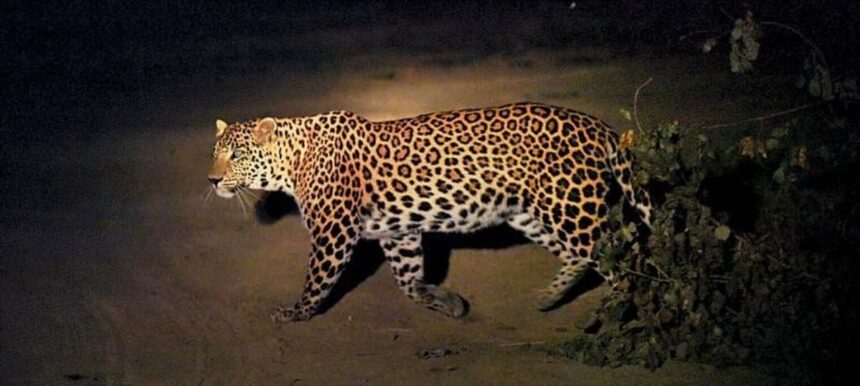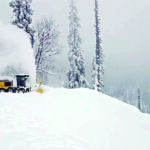Srinagar, Apr07:Srinagar, April 05: Wildlife experts and officialssaid that shift in land use patterns, deforestation, lack of solid waste management, construction of developmental projects near forested foothills, and other human encroachments near forest areas have led to the increased presence of wild animals in inhabited areas.
Recent incidents, including a leopard injuring three individuals in Central Kashmir’s Ganderbal district, underscore the urgency of addressing the human-animal conflict. In response, the Department of Wildlife Kashmir is considering professional training and better equipment for its employees to handle such situations effectively.
Following the rise in man-animal conflict, the Department of Wildlife Kashmir is mulling to train its employees professionally and provide them better equipment, tools, gears to handle such cases in future.
Pradeep Chandra Wahule, Regional Wildlife Warden, Kashmir told Rising Kashmir that they will focus on training more and stated there is need for professional ways to handle such cases.
“I also did not want my people to get injured in the process, that is a big concern for the department grappling with the dearth of manpower,” he said.
Wahule said that they have also done mapping of such areas where these leopards are mostly coming towards human habitations. When we have authentic data, then only we can do mapping. After that we can accurately identify vulnerable areas, we cannot open control rooms everywhere.
“We are in the process of mapping all such areas and we are also not sure about the exact leopard population. After that we can advise people about the perceptions priority wise,” he said, adding that after that we can deploy our men to these sensitive places.
Wahule said the department is also expecting positive support from the people, in Ganderbal where a leopard attacked employees, the people were openly out on streets, it could prove more fatal. They should not gather at the spot rather than staying in their homes,” he said.
Chief Wildlife warden said that department has 22 control rooms that are on call 24 hours across the 10 districts of the Valley. We are facing a lack of manpower and cannot be omni present everywhere, he added.
Forests blanket approximately 20% of the land in Jammu and Kashmir, with over half of the Kashmir Valley being shrouded in greenery. The UT boasts a robust network of protected areas spanning 15,912 square kilometers, featuring five national parks, 14 wildlife sanctuaries, and 35 conservation reserves.
Wildlife Warden North Kashmir IntesarSuhail says that Leopards, like many other predators, may occasionally venture into human habitation areas in search of prey due to a variety of factors.
“Habitat loss plays a significant role in this phenomenon. Human expansion into leopard habitats can lead to fragmentation and destruction of natural habitats, forcing leopards to adapt to living in closer proximity to humans and their settlements,” he said.
Suhail says when natural prey populations decline due to habitat destruction, or competition with other predators, leopards may turn to dogs, domestic animals such as livestock as alternative prey sources. Livestock can be easier targets for leopards to catch compared to wild prey, he said.
“As human settlements expand into leopard territories, there is an increased likelihood of human-leopard encounters. Leopards may be forced to seek new territories or adapt to living in close proximity to human settlements,” Suhail added.
Apart from that, he said that human settlements often provide attractants such as garbage, pet food, or livestock pens, which can draw leopards into these areas by offering potential prey or scavenging opportunities.
“To mitigate human-leopard conflict, communities living in areas with leopard populations should implement measures such as proper waste management. Conservation efforts focusing on habitat protection and prey management are also crucial for ensuring the long-term survival of both leopards and their natural prey species,” Suhail added.
As per official data by the Wild Life Department suggests that between 2011 and 2022, 44 leopards died, and seven were legally killed. Also, nine leopard cubs, four leopard cats, 141 black bears, 12 bear cubs, and seven brown bears were lost. Sadly, many people were hurt too.
“From 2006 to 2022, animal attacks injured 2,918 people and caused 244 deaths. Just in 2022, there were over 30 times when people encountered animals in north Kashmir, leading to 15 deaths, including seven kids.
Another expert, Mohammad ShabirBhat (Shabir) who works mainly in Budgam district said that majority of man-animal conflicts occur beyond the protected area networks, such as orchards, human settlements, and areas where deforestation and encroachments have occurred.
“Earlier due to poaching and open lands, such incidents were reported less. Over the years, leopard incidents have increased in Kashmir as most of the open lands have been turned into dense orchards, making a safe shelter for leopards,” he said.
Bhat said people have also encroached the habitats of leopards and constructed houses, buildings etc. Dogs in civil areas are easy prey for the leopard and waste management in rural and urban areas can mitigate this crisis.
“Ganderbal leopard incident was not an attack, it could have been handled in a better and professional way rather than risking the lives of many employees,” he said.
About the turning of man-eater leopard, Bhat said Leopards turning into man-eaters due to various factors, including habitat loss, human encroachment into leopard territories, depletion of natural prey, and sometimes, individual leopard behavior.
“Sometimes, if a leopard is hurt or sick, it might see humans as an easier meal. To stop this from happening, we need to protect the places where leopards live, teach people how to live safely near them, and use ways to keep leopards away from places where people live,” he added.
Habitat loss & encroachments fuel Leopard incursions into human settlements in Kashmir

Leave a Comment Leave a Comment







